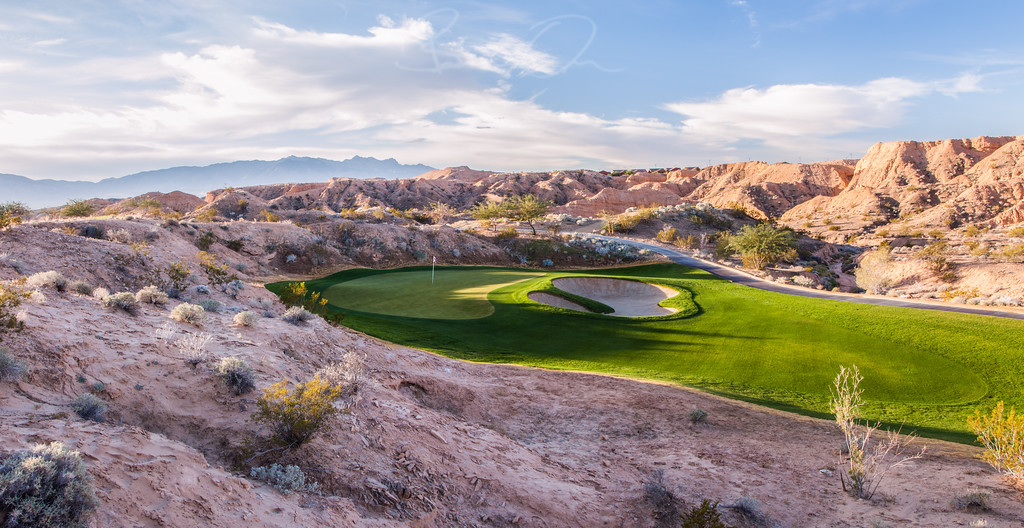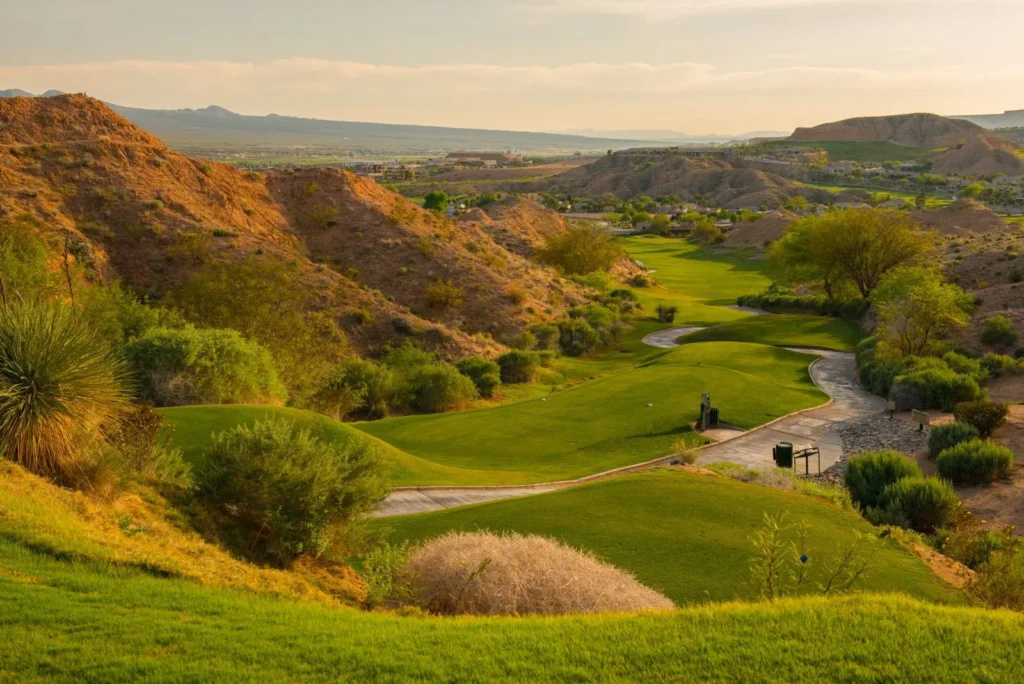
Wolf Creek
Nestled in the enchanting Mojave Desert about an hour and a half northeast of Las Vegas, Mesquite, Nevada offers intrepid travelers an oasis of golfing perfection, casino gambling on a smaller scale than Sin City and a heaving dash of the best of desert vacation life.
There are no less than nine golf courses in the immediate area which many golfers stop and explore, drawn by 300 days of sunshine annually and facilities designed by A-list golf course architects on varied terrain. The courses in Mesquite sport breathtaking views, prompting even the most camera shy player to use their iPhone to document their experiences and the stunning desert landscape vistas.
We offer below snapshots of four courses of varying difficulty, all within two miles drive of I-15 as it crosses the city from west to east on the extreme northeast corner of Nevada — the peerless and picturesque Wolf Creek Golf Club; the Gary Panks-designed Conestoga Golf Club; the Palmer Course at Oasis Golf Club; and Casablanca Golf Club, a Cal Olsen course originally commissioned by talk show host and game show magnate Merv Griffin.
Everything you’ve heard about Wolf Creek is true, including its degree of difficulty
No feature on the courses of Mesquite can begin without first mentioning Wolf Creek Golf Club, the mind-bending track fashioned in the desert canyons north of the downtown area by neophyte and one-off design team of brothers Dennis and John Rider in 2000.
Wolf Creek looks and plays like a fantasy course designed for a video game and includes huge elevation drops, a dozen forced carries over stunning arroyos, white-sand bunkers, selectively placed water features and some of the best high desert views anywhere.
Some golf course marketing plans claim that their course “offers 18 signature holes, not just one” but never has that statement been closer to reality than at Wolf Creek. Virtually every tee box initially produces a “wow” factor that quickly ebbs when the player has to execute near flawless shots to have even a modicum of scoring success.
The round begins with an initial taste of what’s to come via a 579-yard par-5 that plays downhill off the tee and uphill to a long, thin, multi-tiered putting surface.
The 445-yard par-4 second is an absolute stunner dropping more than 110 feet to the fairway that doglegs to the left. The fairway looks like a green sliver in the distance but a fairway wood will bite off enough of the dogleg to leave golfers with a short iron into the green.
The par-5 fifth hole plays at 490 yards and is reachable in two if you bite off enough. It’s downhill from the tee and an aggressive drive will leave you with a 5- or 6-iron uphill to an undulating green.
The 12th is maybe Wolf Creek’s most photographed hole. It’s a downhill par-5 with what looks to be a very generous fairway that tilts almost imperceptibly to the left towards a large pond.
The 444- yard 14th sweeps right to left along the top of desert with the landing area narrowed by six bunkers that line the inside of the dogleg. Played to the right, the approach allows a better angle to the green – it’s a great visual hole that is fun and challenging to play.
Wolf Creek’s penultimate hole is a longish, risk-reward par 5 with an awesome downhill tee shot. A well delivered shot off the tee gives the golfer a notion of going for the putting surface but prudence is best as the green is protected by water in front and on the right and there is scant with little space to bail out.
Many golfers consider Wolf Creek a fantasy calendar come to life. There isn’t a single boring hole on this golf course — it’s a rolling, rollicking good time, and (if you are on your game) a blast to play and challenge your game.

Wolf Creek
Conestoga is worth its weight in gold
If Wolf Creek is the No. 1 golf course in Mesquite, Conestoga Golf Club is No. 1A — with a bullet.
Designed by Panks, the routing meanders through canyons and between rocky outcroppings, weaving through the rocky landscape early in the round before wrapping around a pond at the turn and then playing along tamer terrain with some holes framed by current and future residential development.
The fairways at Conestoga are wide for a desert layout and allow golfers a bit of scatter knowing that there is some room to miss. Forced carries are de rigueur per the high-desert terrain on the vast majority of tee shots in order to find the grass.
There are a multitude of bunkers throughout the course and each seem to be in a place where they affect scoring. The front nine at Conestoga is just flat out fun and clearly the more memorable and enjoyable of the two nines.
The par-3 second hole sets the table here, playing at 188 yards from an elevated tee with a commanding view of the surrounding property and the tee shot’s generous target. A rock wall creates the border around the green separating the trees complex from a (usually) dry desert wash.
The 394-yard par-4 fourth is known as the “Fence Hole” because of the wooden fence that borders the fairway about 250 yards off the tee and delineates the edge of a canyon. The landing area picks up again at the bottom of the canyon, making golfers choose to lay up off the tee or attack the hole to set the table for a wedge shot to the green.
The sixth hole is a reachable par-5 but has three forced carries on the way to the putting surface. A good drive leaves about left 225 yards to the green but players can lay up to a second fairway and leave themselves as little as 100 yards to the flag.
Conestoga is the tale of two nines as the back side traverses over open desert areas and residential development with a more traditional feel than the front.
The picturesque 198-yard 10th hole, with a mountain backdrop and a putting surface set in front of a tumbling waterfall, is one of Mesquite’s most memorable holes.
The 17th also has a bit of a canyon offering at 423 yards, with a tee shot that plays downhill to a mostly blind landing area where you run out of room at 325 yards. Take into consideration the prevailing wind at your back and the downhill terrain before you grip it and rip it. The hole takes a turn left as it gets close to the green, which is guarded by bunkers in the front and rear.
With water in play on just two holes, you likely won’t lose many balls at Conestoga provided you keep it out of the surrounding desert. Conestoga doesn’t have as extreme of terrain or views of Wolf Creek, but still delivers a flavor of desert canyon golf blended with some straight-forward traditional style holes and is worth its weight in gold.

Conestoga
Palmer Course at Oasis Golf Club is anything but a mirage
Prior to Wolf Creek being added to the Mesquite golf scene, the Palmer Course at Oasis was the destination course here, Like Conestoga (though more so) the routing at the Palmer combines holes that run through residential development with holes that cut through the desert canyons and mesas with a handful elevation changes.
The design has some corridors that are framed by towering rocky outcroppings. Palmer’s work effectively uses the desert terrain and includes several elevated tee shots to landing areas that appear smaller off the tee than they actually are (but that’s what Palmer is known for).
At 6,455 yards from the back tees, the par-71 Palmer Course doesn’t have punishing length, but it does feature a few strategic water features and an overall intriguing designs.
The 424-yard third lives up to the club’s Oasis namesake with a tee shot that plays downhill to a blind landing area before continuing down to a greens complex that is fronted by a pond and backed by palm trees.
On the 534-yard fifth the tee shot is played to a fairway some 100 feet below, with the landing area carved through an arroyo. Players that successfully find the fairway will have a great chance of reaching this green in two.
No. 7 at the Palmer Course at Oasis is a 157-yard one-shotter over a desert ravine to a green protected by three bunkers. If the pin is left make sure you take enough club to clear the hazard off the tee.
The back nine begins with a par-4 that is carded at only 299 yards from the back tees but plays uphill with a slight turn to the left. Golfers laying up off the tee will face an approach shot to a shallow, but wide, green that is fronted on the right side by a bunker.
The 444-yard 11th is the longest and most demanding par-4 on the course and also starts on an elevated tee with trouble lining both sides of the fairway. Bunkers wait on the right while on the left a large pond demanding the golfer to stay away. The water runs the entire left side of the hole all the way to the green and continues to be a factor to contend with on the course and in your head. Par here is a stout accomplishment.
The 384-yard 18th hole is a fun finisher, with another big, elevated tee shot and dogleg-right move around and over the pond.
After playing Wolf Creek and Conestoga, the Palmer Course at the Oasis Golf Club might seem a little tame — but that’s okay. It’s a solid layout and clearly a wonderful option for golf here.

Palmer Course at Oasis Club
CasaBlanca is likely Mesquite’s true ‘resort’ course
As a “resort, links-style” golf course, CasaBlanca Golf Club is a great compliment and much needed change from the three courses above because of its overall playability and friendliness for the higher handicap golfer.
Olsen’s design (commissioned by Griffin in the late 1990s as an amenity for his nearby casino-resort) is set amidst a landscape of sagebrush, tumbleweeds and palms and has a unique-to-the-area wetlands running alongside the fairways of many holes. Water comes into play on 13 holes as this course meanders along the edge of the Virgin River.
The natural areas that line the routing are protected due to the sensitivity in relation to the abundant wildlife that call the desert areas home.
The front side opens up with some desert type holes that require sometimes lengthy carries over washes and natural areas.
The par-4 first plays at 396 yards and slightly downhill with a generous fairway and is a good opener. The second, a par-5 of 507 yards, is also very playable, especially if you avoid the fairway bunker on the right and enter the green from the middle to left side of the fairway.
The 315-yard par-4 third tempts long drivers to go for it off the tee, but an accurate long iron or fairway wood will leave an easy approach and a possible birdie opportunity.
Water plays a prominent role in the design of Nos. 7 and 8 as shots approaching the putting surfaces on the mid-range par-4 and long par-3 must steer clear of the lake along the right side.
No. 10, at 425 yards, plays downhill with a tight approach while the par-5 11th has a snaking fairway that tightens in stretches.
Straight, long hitters are presented with a classic risk/reward opportunity on the 308-yard 13th, on which it is entirely possible to reach the green off the tee. Conversely, No. 15 is the longest hole at CasaBlanca at 565 yards.
Wetlands on either side choke the fairway on the 458-yard par-4 17th, making the approach a demanding test. A mid or short iron is the preferred club of choice here as you attack the putting surface; course officials estimate that more balls are lost here than on the rest of the course combined.
CasaBlanca’s layout is mostly flat and very wide in places and quite forgiving although its fairways are deceivingly undulating, It may be the only course in Mesquite which lends well to walking.
The course here is annually home to the Nevada Open and Mesquite Amateur championships so it’s got chops in spades (or hearts or clubs or diamonds).

CasaBlanca

